It’s rare that a computer component sets pulses racing beyond the tech industry. But when Nvidia Corp. issued a blowout sales forecast in May to send its market value above $1 trillion, the star of the show was its latest graphics processing unit, the H100. The new data center chip is showing investors that the buzz around generative artificial intelligence — systems that can perform a wide range of tasks at superpowered speed — is translating into real revenue, at least for Nvidia. Demand for the H100 is so great that some customers are having to wait as long as six months to receive it.
The H100, whose name is a nod to computer science pioneer Grace Hopper, is a graphics processor. It’s a type of chip that normally lives in PCs and helps gamers get the most realistic visual experience. Unlike its regular counterparts, though, the chip’s 80 billion transistors are arranged in cores that are tuned to process data at high speed, not generate images. Nvidia, founded in 1993, pioneered this market with investments in technology going back almost two decades, when it bet that the ability to do work in parallel would one day make its chips valuable in applications outside of gaming.
Have a confidential tip for our reporters? Get in Touch.
